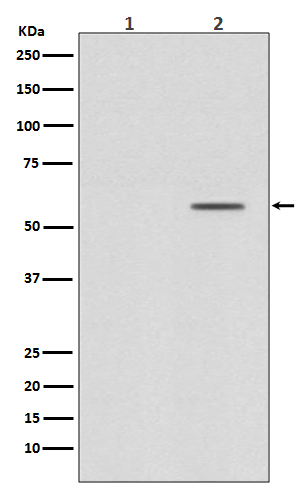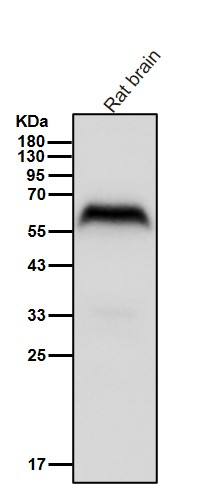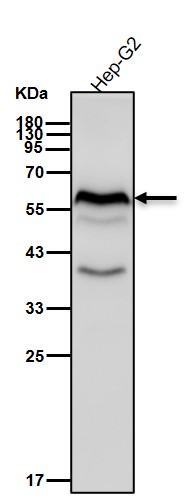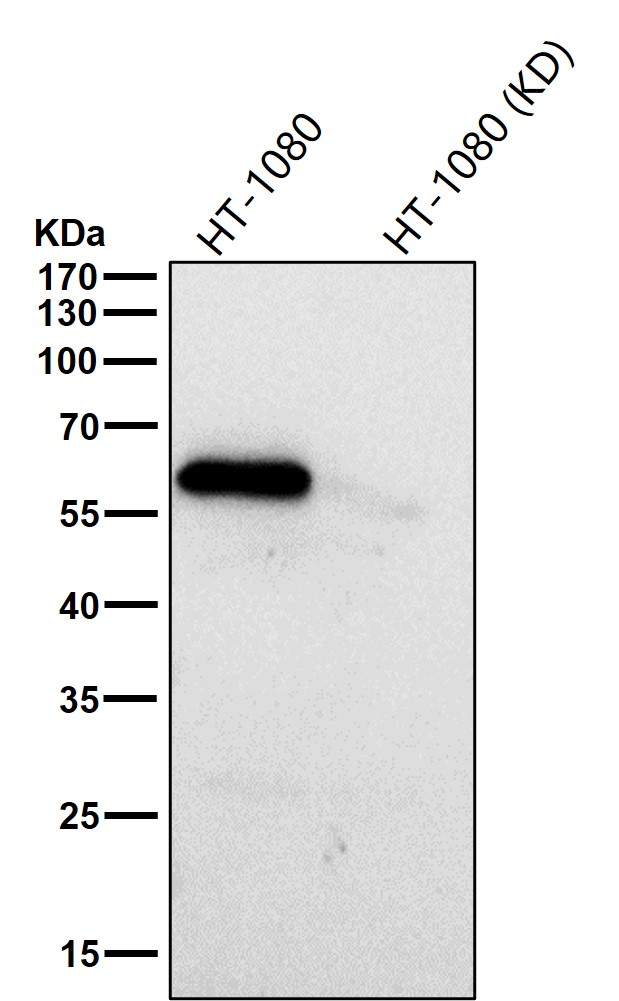




| WB | 1/1000-1/2000 | Human,Mouse,Rat |
| IF | 咨询技术 | Human,Mouse,Rat |
| IHC | 咨询技术 | Human,Mouse,Rat |
| ICC | 技术咨询 | Human,Mouse,Rat |
| FCM | 1/20-1/100 | Human,Mouse,Rat |
| Elisa | 咨询技术 | Human,Mouse,Rat |
| Aliases | JV18-1, MADH2, MADR2, Mad-related protein 2, Mothers against DPP homolog 2, Mothers against decapentaplegic homolog 2, Smad 2;;p-SMAD2 (S250) |
| WB Predicted band size | Calculated MW: 52 kDa ; Observed MW: 58 kDa |
| Host/Isotype | Rabbit IgG |
| Antibody Type | Primary antibody |
| Storage | Store at 4°C short term. Aliquot and store at -20°C long term. Avoid freeze/thaw cycles. |
| Species Reactivity | Human,Mouse,Rat |
| Immunogen | A synthesized peptide derived from human SMAD2 around the phosphorylation site of S250 |
| Formulation | Purified antibody in PBS with 0.05% sodium azide,0.05% BSA and 50% glycerol. |
+ +
以下是关于Phospho-Smad2(S250)抗体的3篇参考文献示例(注:实际文献需根据具体数据库检索确认,以下为模拟内容):
---
1. **文献名称**:*"TGF-β-induced phosphorylation of Smad2 at Ser250 regulates epithelial-mesenchymal transition in cancer"*
**作者**:Zhang Y, et al.
**摘要**:本研究揭示了TGF-β信号通路中Smad2在S250位点的磷酸化对肿瘤细胞上皮-间质转化(EMT)的调控作用,通过Phospho-Smad2(S250)抗体验证了该位点磷酸化与肿瘤转移的相关性。
---
2. **文献名称**:*"Role of Smad2 Ser250 phosphorylation in embryonic stem cell differentiation"*
**作者**:Li H, et al.
**摘要**:利用Phospho-Smad2(S250)抗体,作者发现该位点的磷酸化在小鼠胚胎干细胞向中胚层分化过程中起关键作用,并证明其与BMP信号通路的交互调控。
---
3. **文献名称**:*"Specific detection of phosphorylated Smad2 (Ser250) in autoimmune disease models"*
**作者**:Wang X, et al.
**摘要**:通过开发高特异性Phospho-Smad2(S250)抗体,研究团队在系统性红斑狼疮(SLE)患者样本中检测到异常升高的S250磷酸化水平,提示其作为疾病生物标志物的潜力。
---
**注意**:实际文献中Smad2的磷酸化位点常见于C端(如Ser465/Ser467)或中间连接区(如Thr220),S250可能为特定研究中的非经典位点。建议结合具体研究背景通过PubMed或Google Scholar检索确认。
Phospho-Smad2 (S250) antibodies are essential tools for studying the TGF-β (transforming growth factor-beta) signaling pathway, which regulates diverse cellular processes, including proliferation, differentiation, and apoptosis. Smad2. a receptor-regulated Smad (R-Smad), is activated via phosphorylation by the TGF-β type I receptor kinase. While canonical Smad2 activation involves phosphorylation at C-terminal serine residues (S465/S467), phosphorylation at the serine 250 (S250) site represents a non-canonical modification associated with distinct regulatory mechanisms. This phosphorylation event has been implicated in fine-tuning Smad2 activity, potentially modulating its interaction with co-regulators, subcellular localization, or stability.
Phospho-Smad2 (S250)-specific antibodies enable researchers to detect this specific post-translational modification in techniques like Western blotting, immunofluorescence, or immunohistochemistry. Such antibodies are critical for investigating context-dependent TGF-β signaling dynamics, particularly in pathological conditions like fibrosis, cancer, or immune disorders, where aberrant Smad2 activation may drive disease progression. Studies suggest that S250 phosphorylation might occur independently of TGF-β receptor activation, possibly through alternative kinases (e.g., MAPK or CDK family members), highlighting its role in crosstalk with other signaling pathways.
Validation of these antibodies typically involves using cell models with induced phosphorylation (e.g., TGF-β stimulation) or genetic/pharmacologic inhibition to confirm specificity. Researchers must ensure minimal cross-reactivity with other Smad proteins (e.g., Smad3) or non-phosphorylated Smad2. Understanding S250 phosphorylation's functional impact remains an active area of research, making these antibodies valuable for unraveling Smad2's complexity in health and disease.
×